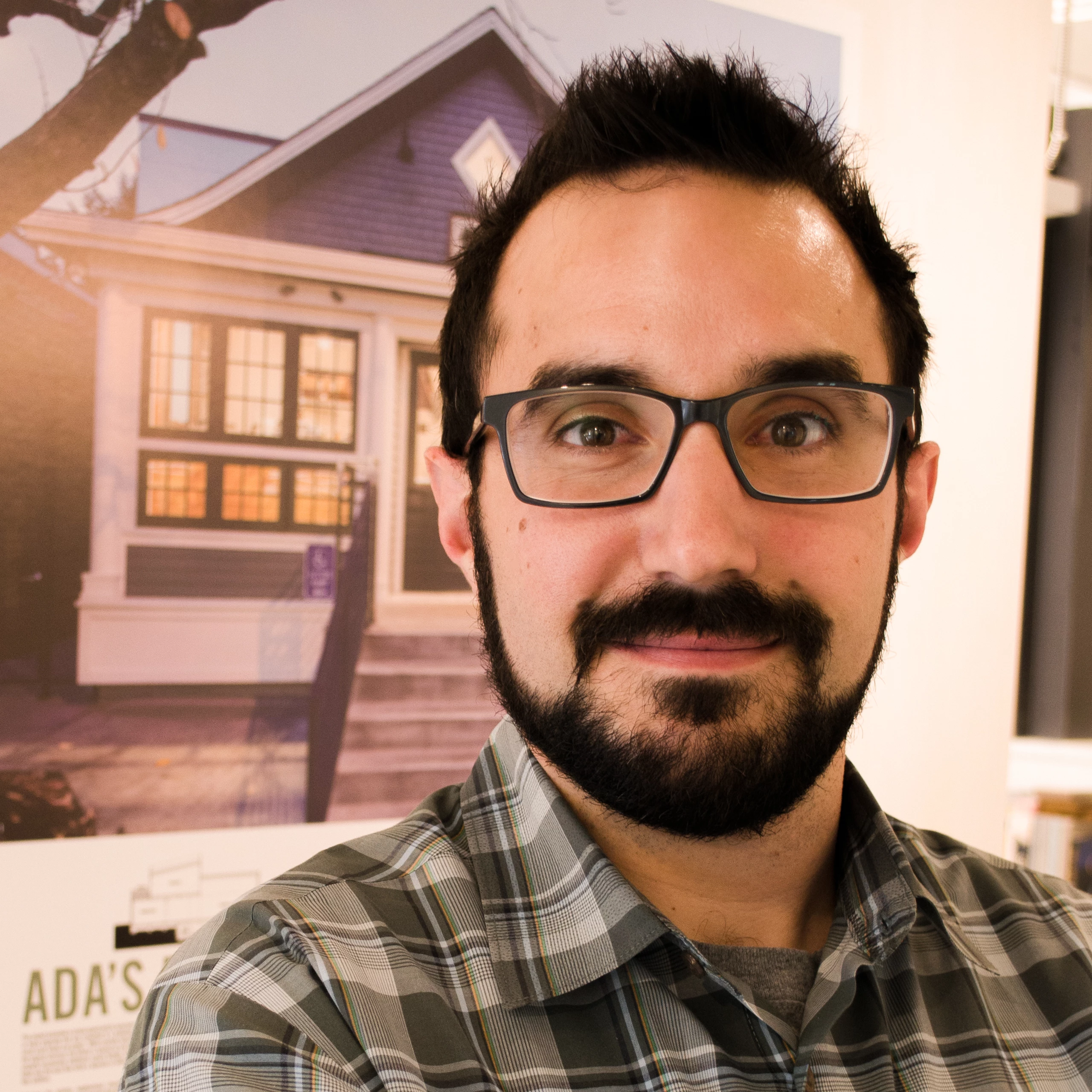
Building Green
Questions To Ask About Sustainability
Board & Vellum’s first employee is starting off on a new adventure. As a farewell blog post, he asked people around the office about something really important to him: what questions they ask themselves — and think others should ask — about sustainability in terms of homes, landscapes, and workplaces.
July 25, 2019
Deep thoughts on sustainability.
Hello, world. I have some big news. I am heading off to Colorado for a big new adventure. It’s crazy to look back at all that I got to do here at Board & Vellum over the past seven years. I got to work with awesome folks, work on incredible projects, and build relationships with contractors, consultants, structural engineers, and building supply reps. I learned the importance of collaboration and giving and receiving feedback. I also made some mistakes and learned from them along the way. One of the biggest take-aways from my time at B&V is the importance of asking questions, in finding that delicate balance between just moving forward and asking too many questions.
For my last blog post, I wanted to make sure it was a topic that touched on something near and dear to my heart: sustainable and eco-friendly design and creating well-balanced systems. To stay true to the importance of collaboration, I thought it would be fun to get several different perspectives in the office about what questions folks are asking related to sustainability.
What is the value of quality green building in architecture?
Since the history of time, homes that were largest were seen as the best, regardless of the quality. You still see this today with how homes are marketed. You see the number of square feet and how many bedrooms and bathrooms there are, but nothing much about the really important things.
Questions You Should Really Ask About a House (And Yourself)
I understand that you need to know how many bedrooms there are in a house. But here are some other questions you should really ask about a house before you buy it or build it.
- How watertight are the windows?
- How bombproof is the connection between the window opening and the actual window?
- What kind of air filtration system does this house have?
- What are the toxic materials inside that I am breathing, and what kind of health impacts will this have on my family?
- How much carbon am I adding to the atmosphere by building this way? What kind of impacts will that cause to my community and the planet?
- What value do I put on your health?
- What value do I put on maintenance?
- What value do I put on food, water, and clean air?
- How do I feel in the space?
We really need to start valuing quality and longevity, so we stop wasting resources (including money). Often times when we design a house, there is the “cheap” option and the “expensive” option. And it can be too easy for people to want to go for the less-expensive option. The funny thing about this is that if you build small but high-quality, or you build large and cheap, both will eventually cost the same over the life of the project.
As architects, we try to push for the best quality because that’s what’s best for everyone. We don’t have to worry about a home possibly failing because we know we used the best resources available at that time. And, we get to collaborate with builders, consultants, structural engineers, and many others to teach each other the best techniques to help push the industry to create better homes for us now and for future generations. The client gets a new home that will be low maintenance, healthy, safe, that looks great, and that they’ll want to care for many generations. Oh, and they help the planet. So why do we cut quality to save cost? At the end of a 30-year mortgage, I can pretty much guarantee if you build by choosing cheap and fast methods, your home will not last and will end up costing more than just doing it right at the start. I advocate for quality.
What is the cost of maintenance for your landscape? (On the planet, and your wallet.)
Let's set a scene - you've got this blank canvas of an outdoor space, and you are not sure what to do with it. Do you plant a perennial garden, expand the lawn, plant a tree grove? There are many, many aspects to consider here, but one aspect that flies under the radar is long-term maintenance. Each type of landscape requires its own type of maintenance, and each type of maintenance comes with its own carbon cost. In architectural design, we talk a lot about the embodied carbon of materials, which identifies the amount of energy and carbon it takes to turn raw materials into a finished design element. The other half of the equation is the operational carbon, which is more related to energy and carbon associated with all the maintenance inputs through the lifespan of that material and design.
With buildings, the operational carbon is usually lower than the embodied carbon. With site design, the balance is flipped.
Most landscape types require less material with embodied carbon, but we see tremendous amounts of energy needed to maintain landscapes, which increase the total operational carbon over time.
The Real Impact of Lawn Care
For this discussion, let’s focus on the archetypal American grass lawn because it is a prevalent component in most human-designed landscapes. These lawns provide for clear visibility, order, and flexible play/entertainment space for the family. Weekends are filled with time spent mowing, clipping, edging and blowing to maintain the control and order of the manicured lawn. Whether you or a maintenance crew is managing the weekly maintenance routine, the time and money inputs are visible to most. The carbon output necessary to maintain this style of landscape is more opaque, yet equally as critical a metric to consider when deciding if a lawn is right for your site.
In a Swedish study from 2001, and a comparable study in 2003, it was documented that two-stroke engines (the type of engine used in most residential-scale lawn equipment) is not a highly efficient engine and emits more pollutants than a three-ton Ford pickup truck. One study claims, “the hydrocarbon emissions from a half-hour of yard work with the two-stroke engine is about the same as a 3,900-mile drive from Texas to Alaska in a [Ford] Raptor.” It is important to recognize traditional lawn-care maintenance as as much of an impediment to sustainability as driving a huge gas-guzzling truck. It is hard to believe these beautiful green spaces require so much pollution to maintain, but it helps frame your perspective of certain landscapes and their role in a sustainable future.
The easy fix for the DIY gardener is to only use high-quality, electric lawn care equipment with rechargeable batteries. Fairly simple solution in the short term. But from a commercial point of view, persuading an entire lawn care industry and the entrenched municipal systems to convert all their equipment over to electric takes a considerable amount of capital and red-tape-avoidance. This is certainly a conversation worth having and will likely be the future of the industry, but in the meantime, planning and forethought can go a long way in reducing the carbon footprint of your landscape today.
At B&V, we are continuing to support the integration of numerous types of landscapes — orchards, perennial gardens, reforestation, meadows — in residential and commercial sites, all of which have significantly lower maintenance requirements and provide beneficial ecosystem services, in addition to natural beauty and sense of place. We find beauty in knowing a well-organized site design can offset more carbon over its lifespan than is produced through the design, implementation, and long-term maintenance.
What is the impact of a healthy workplace?
I’ve had the unique opportunity to spend my career in HR as well as sustainability. My goal is always to create healthy, safe environments for people to work in. When you think about green building, you may think of non-toxic materials, low-flow fixtures, and energy-efficient lighting. This is all true and makes for a building that saves energy and resources, thereby having a positive impact on the environment. What I like to look at, is how sustainable buildings impact an employee’s experience and the overall productivity and success of an organization.
The Relationship Between Healthy Workplaces and Productivity
You may have read or heard that employees who work in green buildings use fewer sick days and are more productive. A 2017 study from Harvard and SUNY Upstate Medical University found that employees doubled their cognitive test scores after experiencing increased ventilation, which you would find in a green building. The study also found that green buildings help employees sleep better and feel better, which allows for more productivity and increased energy at work. And who doesn’t want to work in an office with natural daylight, operable windows, and non-toxic materials? Green building practices are a way to attract employees to organizations and creating an engaging place to work creates happier and more productive employees, therefore reducing turnover. All of this lends itself to a more creative, collaborative, and happier environment, which leads to increased profits, innovative thinking, and great places to work. It’s all a win-win!
When we speak about sustainability and healthy workplaces, we also want to open the lens on equity, diversity, and inclusion as a part of the conversation — a sustainable workforce is open to opportunities for all, and considers all points of view in the conversation. Certification programs like BCorp and Just allow us to look at the employee experience in a holistic way and allow us to work towards ideal workplaces for everyone. Everything from green building to transparency, fair pay practices, safe working environments, etc. should be evaluated and improved upon.
We spend the majority of our days in our workspace, so making sure that space is healthy in every way possible will contribute to a positive culture and the overall success of an organization.
What is the value of a healthy environment for my kids?
The legacy of what we build is left to our children and grandchildren. To quote the late, great, Whitney Houston (why are you not surprised my bit of this blog starts with this…), “I believe the children are our future. Teach them well and let them lead the way.” Now, cheeseball lyrics aside (and I apologize for getting that song in your head), there’s a reason why we all tend to admire and respect great old buildings. They were built to last.
Build to Last
The buildings we build now should be ones that not only last for a very long time, but that also create healthy environments for our kids. Teaching them about the value of a healthy environment means it doesn’t become something they have to teach their kids, it is just something that is their baseline. I talk a lot with my boys about the things that a good designer does — to show them the value of great air quality, let them learn about materials that don’t off-gas horrible chemicals for them to breathe into their developing bodies, and explain how quality materials will last, while shoddy ones will just need to be replaced.
I certainly didn’t become a CPHC (Certified Passive House Consultant) for my kids, but the more they grow up, I realize that I build upon my base of understanding and knowledge for them and for their kids.

 Ryan Adanalian
Ryan Adanalian Taylor McNeill
Taylor McNeill Michelle Wolfe
Michelle Wolfe Jeff Pelletier
Jeff Pelletier

